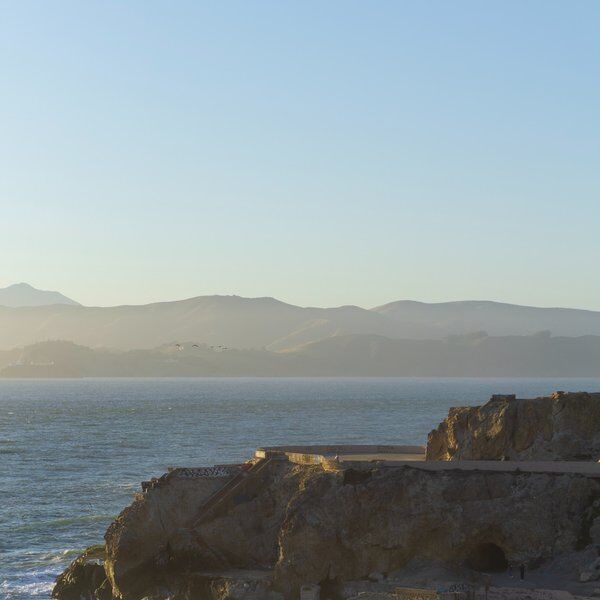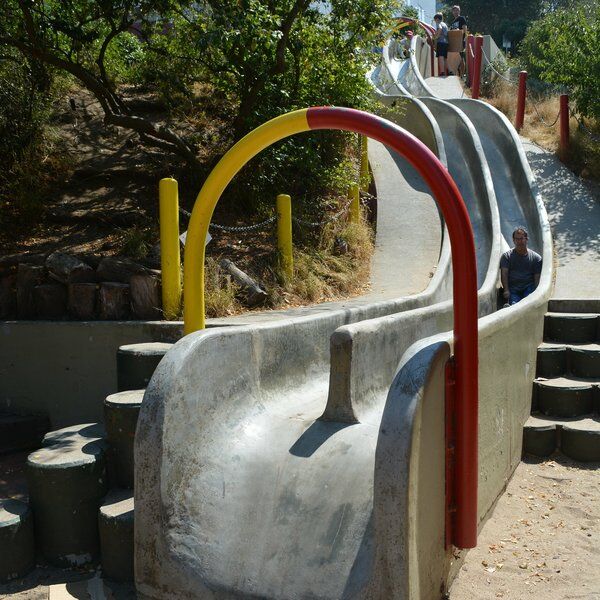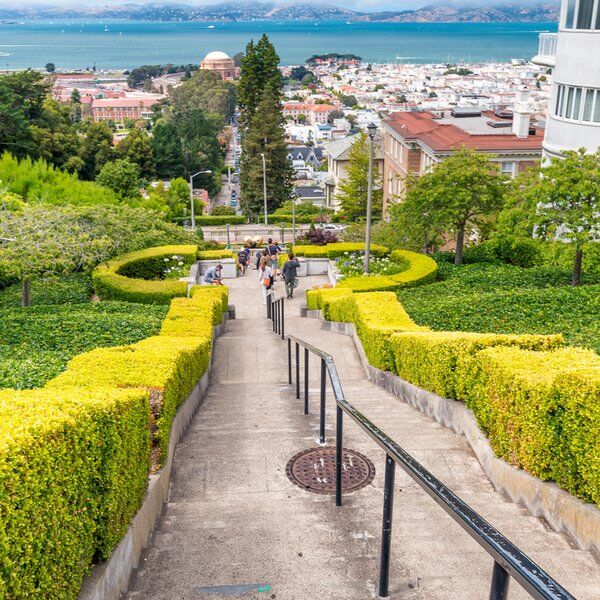Discover Twin Peaks in San Francisco
Before we get onto Christmas Tree Point it's important to discuss San Francisco’s Twin Peaks. Located near the city’s center, these peaks comprise two nearly identical hills, each standing around 925 feet (282 meters) tall, making them the second and third highest natural points in San Francisco.
The summits, known as Eureka Peak (north) and Noe Peak (south), are separated by approximately 660 feet (200 meters). Thanks to its central location and elevation, Twin Peaks provides one of the best vantage points in the city, attracting tourists and locals.

What is Christmas Tree Point?
Christmas Tree Point, is a well-known overlook on the Twin Peaks’ northern summit, particularly popular for its stunning 180-degree views. At approximately 70 feet (20 meters) below the summit, it offers breathtaking panoramic views of San Francisco’s most well-known landmarks, such as Alcatraz, the Golden Gate Bridge, the Bay Area, and downtown San Francisco.
On clear days, the vistas extend to Cobb Mountain, 120 kilometers to the north, and Santa Ana Mountain, about 143 kilometers to the southeast. It's also possible to glimpse as far south as the Santa Clara Valley, if the city’s infamous fog isn’t lurking.
Speaking of fog, the point also plays a critical role in dividing the city's weather patterns—its west-facing slopes receive strong winds and fog from the Pacific, while the east-facing slopes enjoy more sunshine and warmth.
Not only does Christmas Tree Point have incredible views, but it is also part of the Twin Peaks Natural Area. This 31-acre park, managed by the San Francisco Recreation and Parks Department, is a haven for wildlife and one of the few places in the Bay Area where the endangered Mission Blue Butterfly thrives. This is thanks to the area’s conservation program, which protects the butterfly alongside supporting various bird species, insects, and native plant life.

Why Is the Overlook Called Christmas Tree Point?
The name "Christmas Tree Point" has an interesting backstory that dates to the 1920s. In 1927, the San Francisco Examiner newspaper launched a festive promotional campaign by setting up a massive Christmas tree at the northern peak. The 120-foot fir tree was transported from Mendocino County and reassembled at the summit, where it was decorated with thousands of lights. The impressive tree became a major spectacle, visible from across the Bay Area, and was lit nightly from sunset until the early morning hours.
The tradition, though short-lived, left a lasting mark on the city. The area surrounding the summit became known as Christmas Tree Point, a name that has persisted for nearly a century. Though the original tree is long gone, the association with the holiday season has cemented the name into San Francisco's history.

Twin Peaks’ History
Before the arrival of European settlers, the indigenous Ohlone people may have used Twin Peaks as a lookout or hunting ground, thanks to the site's high vantage point. In the 18th century, Spanish settlers named the hills "Los Pechos de la Chola," or "Breasts of the Maiden," due to their twin-like appearance.
Over time, Twin Peaks became integral to the growth of San Francisco. The area was once used for ranching during the Spanish colonial era, and its central location later played a crucial role in city planning. As one of San Francisco's "Seven Hills," Twin Peaks became an iconic geographical feature, offering both practical and aesthetic value.
In more recent years, the city has made efforts to enhance accessibility to the site, with the SFMTA introducing traffic-calming measures in 2016. Today, the western side of the figure-eight road around the peaks is open to vehicles, while the eastern side is reserved for pedestrians and cyclists.

Hiking to Christmas Tree Point
The Creeks to Peaks Trail
Hiking to Christmas Tree Point is a popular way to experience the Twin Peaks. One of the popular routes is the Creeks to Peaks Trail, which starts in Glen Canyon Park. This urban hike follows the Islais Creek and winds its way through South San Francisco before ascending Twin Peaks.
The trail includes a variety of terrains, from steep stairways to wooded paths. As you hike, you'll also pass by the towering Sutro Tower, a recognizable fixture of the San Francisco skyline, which many residents use as a navigational landmark when fog blankets the peaks.
Noe Valley to Twin Peaks
For those looking to extend their adventure, the hike can begin in the neighborhood of Noe Valley. Starting at Noe Valley Courts, a popular local park, this route takes you through the pretty residential streets of San Francisco’s before heading uphill to Twin Peaks. Along the way, you’ll pass various hidden staircases that challenge even seasoned hikers.
One of the unique features of this hike is the crossing of Market Street via an elevated pedestrian walkway, offering a striking view of the Financial District. From there, the hike continues through tree-lined streets and urban stairways before reaching the more rugged terrain of Twin Peaks.
To read about some of San Francisco’s steep and quirky stairways, click here: 16th Avenue Tiled Steps - San Francisco, United States.
Reaching the Twin Peaks Summit
Once you’ve reached the trailhead at Crestline Drive and Vista Lane, you’re just a short climb away from the summit. The well-maintained wooden steps guide you to the top, where Noe Peak (the southern hill) and Eureka Peak (the northern hill) await. Both peaks offer incredible views, with Eureka Peak providing particularly sweeping vistas of the Golden Gate Bridge and downtown San Francisco.
After conquering the peaks, the final destination is Christmas Tree Point Overlook. Here, hikers are treated to the most impressive views, including distant peaks like Mount Diablo and Mount Tamalpais on clear days.

Visiting Christmas Tree Point
Twin Peaks, including the Christmas Tree Point parking lot, is open every day from 5:00 am to midnight. Restrooms are available near the main parking area, but there are no other services like restaurants or shops at the summit. As a popular tourist destination, the parking lot can fill up quickly, so arriving early is recommended. While public transportation doesn’t reach the top of the peaks, you can get close by taking the 37 Corbett Muni line, which stops near a walking path up to the summit.
Tips for Visiting
For the best experience, many visitors opt to climb the additional 70 feet to the very top of the North Peak. While the main viewpoint at Christmas Tree Point is spectacular, the summit offers an even better view, making the short but steep ascent worthwhile.
Here are some other visiting tips:
- Check the Weather: San Francisco's infamous fog can obscure the view from Christmas Tree Point. If possible, plan your visit on a clear day to make the most of the panoramic vistas.
- Dress in Layers: Due to its elevation, Twin Peaks tends to be cooler and windier than other parts of the city. A windbreaker or jacket is a smart choice, especially during the evening.
- Bring a Camera: The views here are unforgettable, and capturing the skyline, bridges, and bay is a must for any visitor.
- Poison Oak: For hikers, be mindful of poison oak, which grows in the area.
- Energy and Hydration: While there is often a food truck selling refreshments in the parking lot, packing your own provisions such as water and snacks, are a good idea.
- Be Mindful of Valuables: Unfortunately, car break-ins are not uncommon at the parking lots around Twin Peaks. If driving, avoid leaving valuables in plain sight.
- Consider a Night Visit: Christmas Tree Point is open until midnight year-round, and the city lights make for a stunning nighttime experience with fewer tourists around.

Nearby Attractions
While Christmas Tree Point and the Twin Peaks are the highlights of the area, there are additional nearby attractions worth exploring:
- Sutro Tower: Visible from nearly everywhere on the hike, this iconic TV and radio tower stands tall at 977 feet. It has become an enduring symbol of San Francisco, helping to orient both locals and visitors, especially when the peaks are shrouded in fog.
- Nearby Reservoir: Just north of Christmas Tree Point, one of San Francisco’s reservoirs supplies water for the Fire Department’s firefighting efforts. This reservoir was established after the devastating 1906 earthquake and continues to serve the city’s needs today.
- Neighborhoods: Noe Valley, Castro, and Cole Valley/Haight Asbury are just a short drive or hike down the hill. These vibrant districts are filled with local cafes, shops, and a variety of dining options.
- Additional Hiking: If you're looking to continue your outdoor adventures, consider visiting Glen Canyon Park, a 60-acre wilderness area with its own network of hiking trails.
- Quirky Activities: For a bit of fun, head over to the Seward Street Slides at Seward Mini Park, where you can zip down steep slides on a piece of cardboard. It’s a quirky and exhilarating way to cap off your time at Twin Peaks.

Explore Beyond Christmas Tree Point with CityDays
Once you've enjoyed the views and natural beauty of Christmas Tree Point, why not continue your San Francisco adventure? CityDays offers unique scavenger and treasure hunt tours throughout San Francisco and beyond.
These tours are a great way to bring family and friends—or even dates—together for an afternoon of great fun and adventure, solving clues and snapping photos. Clues will lead you to the big sights and those that you'd walk straight past.
For more information about our San Francisco Scavenger Hunts then click here: Top 6 Immersive San Francisco Scavenger Hunts & Treasure Hunts | CityDays.















